Attached files
| file | filename |
|---|---|
| EX-99.1 - EX-99.1 - NAVISTAR INTERNATIONAL CORP | d597473dex991.htm |
| 8-K - FORM 8-K - NAVISTAR INTERNATIONAL CORP | d597473d8k.htm |
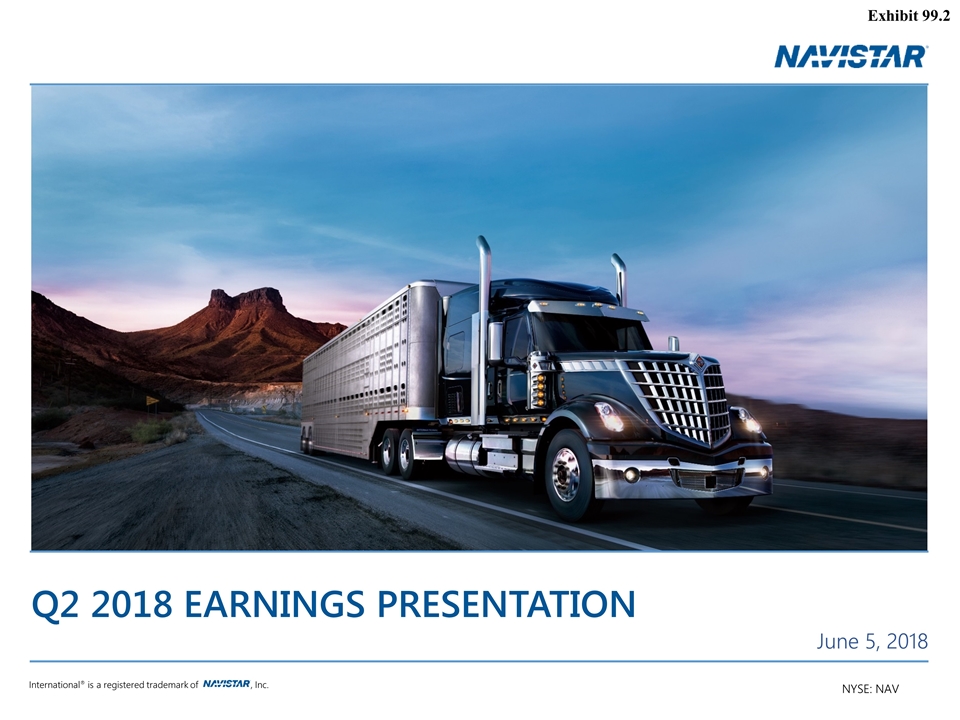
Q2 2018 EARNINGS PRESENTATION June 5, 2018 Exhibit 99.2
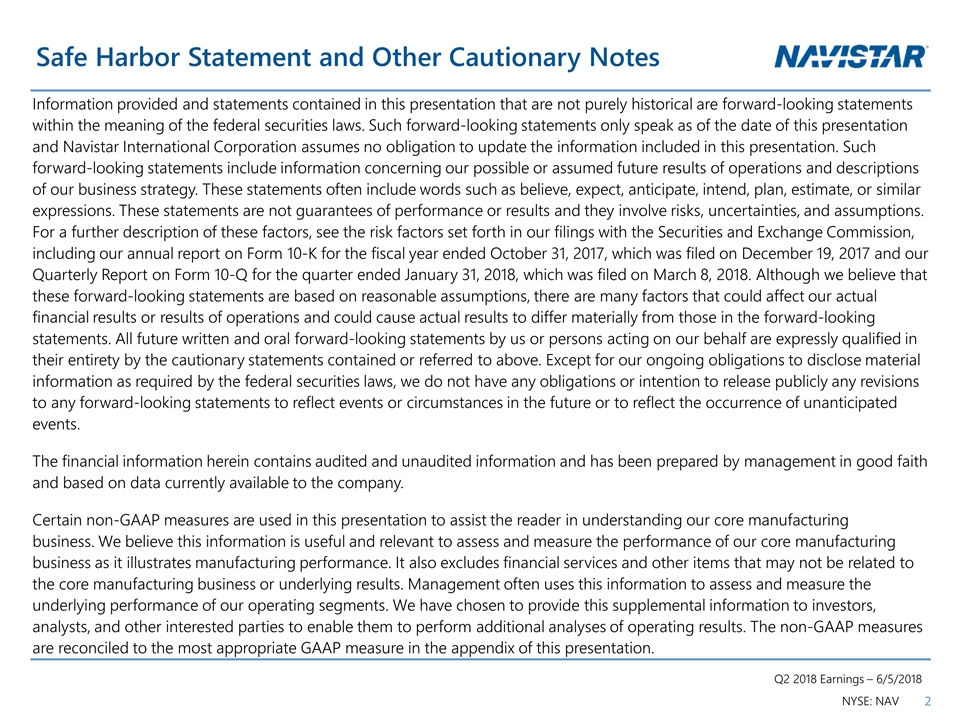
Safe Harbor Statement and Other Cautionary Notes Information provided and statements contained in this presentation that are not purely historical are forward-looking statements within the meaning of the federal securities laws. Such forward-looking statements only speak as of the date of this presentation and Navistar International Corporation assumes no obligation to update the information included in this presentation. Such forward-looking statements include information concerning our possible or assumed future results of operations and descriptions of our business strategy. These statements often include words such as believe, expect, anticipate, intend, plan, estimate, or similar expressions. These statements are not guarantees of performance or results and they involve risks, uncertainties, and assumptions. For a further description of these factors, see the risk factors set forth in our filings with the Securities and Exchange Commission, including our annual report on Form 10-K for the fiscal year ended October 31, 2017, which was filed on December 19, 2017 and our Quarterly Report on Form 10-Q for the quarter ended January 31, 2018, which was filed on March 8, 2018. Although we believe that these forward-looking statements are based on reasonable assumptions, there are many factors that could affect our actual financial results or results of operations and could cause actual results to differ materially from those in the forward-looking statements. All future written and oral forward-looking statements by us or persons acting on our behalf are expressly qualified in their entirety by the cautionary statements contained or referred to above. Except for our ongoing obligations to disclose material information as required by the federal securities laws, we do not have any obligations or intention to release publicly any revisions to any forward-looking statements to reflect events or circumstances in the future or to reflect the occurrence of unanticipated events. The financial information herein contains audited and unaudited information and has been prepared by management in good faith and based on data currently available to the company. Certain non-GAAP measures are used in this presentation to assist the reader in understanding our core manufacturing business. We believe this information is useful and relevant to assess and measure the performance of our core manufacturing business as it illustrates manufacturing performance. It also excludes financial services and other items that may not be related to the core manufacturing business or underlying results. Management often uses this information to assess and measure the underlying performance of our operating segments. We have chosen to provide this supplemental information to investors, analysts, and other interested parties to enable them to perform additional analyses of operating results. The non-GAAP measures are reconciled to the most appropriate GAAP measure in the appendix of this presentation.
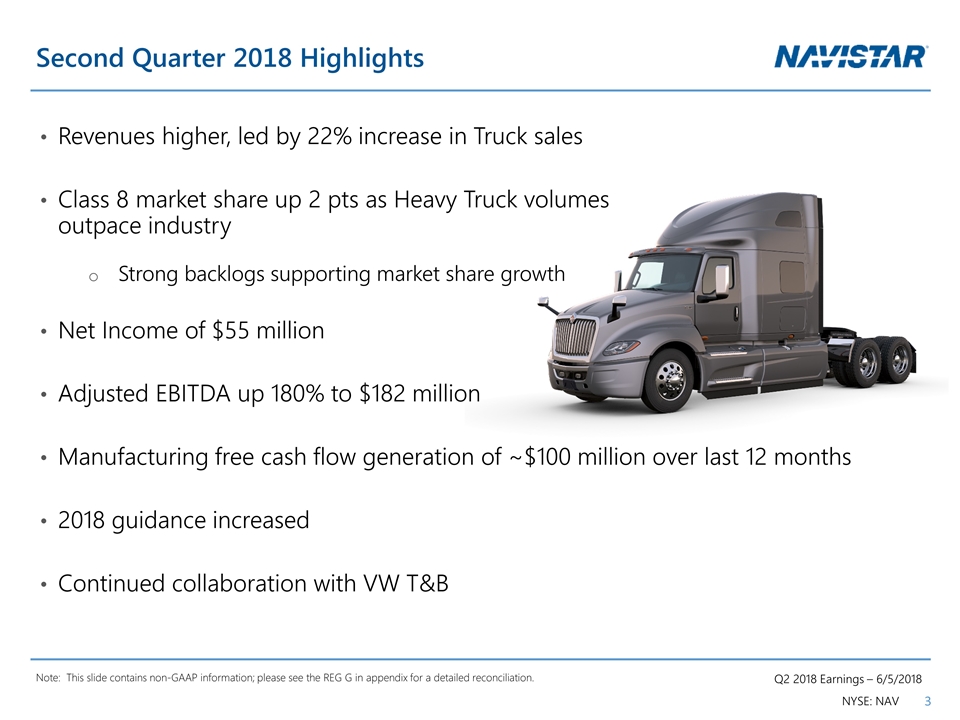
Revenues higher, led by 22% increase in Truck sales Class 8 market share up 2 pts as Heavy Truck volumes outpace industry Strong backlogs supporting market share growth Net Income of $55 million Adjusted EBITDA up 180% to $182 million Manufacturing free cash flow generation of ~$100 million over last 12 months 2018 guidance increased Continued collaboration with VW T&B Second Quarter 2018 Highlights Note:This slide contains non-GAAP information; please see the REG G in appendix for a detailed reconciliation.
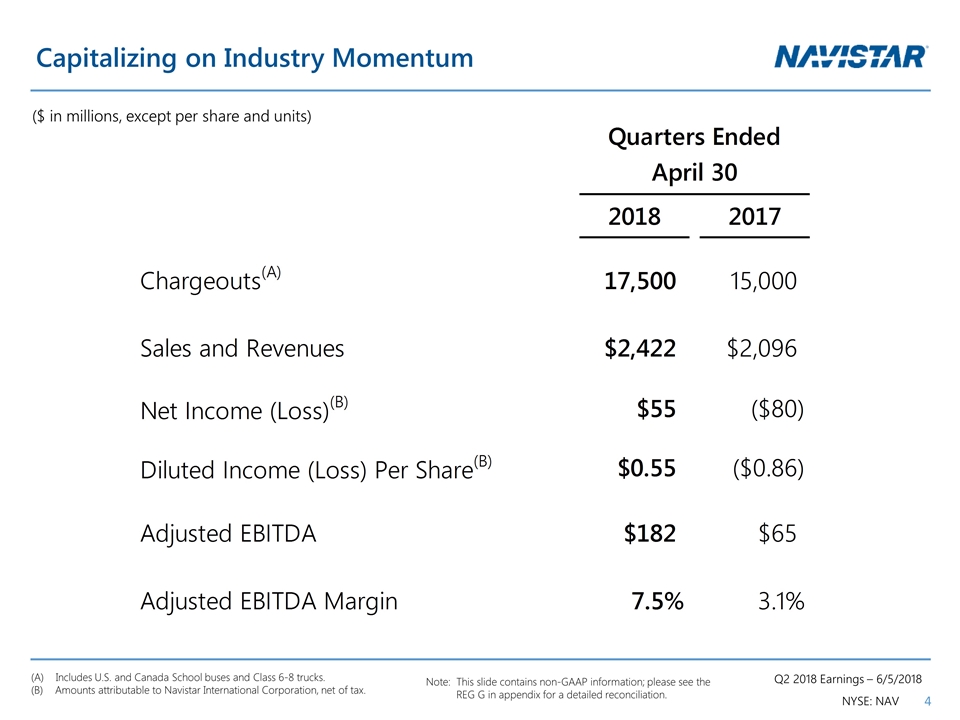
Capitalizing on Industry Momentum ($ in millions, except per share and units) Note:This slide contains non-GAAP information; please see the REG G in appendix for a detailed reconciliation. (A) Includes U.S. and Canada School buses and Class 6-8 trucks. Amounts attributable to Navistar International Corporation, net of tax.
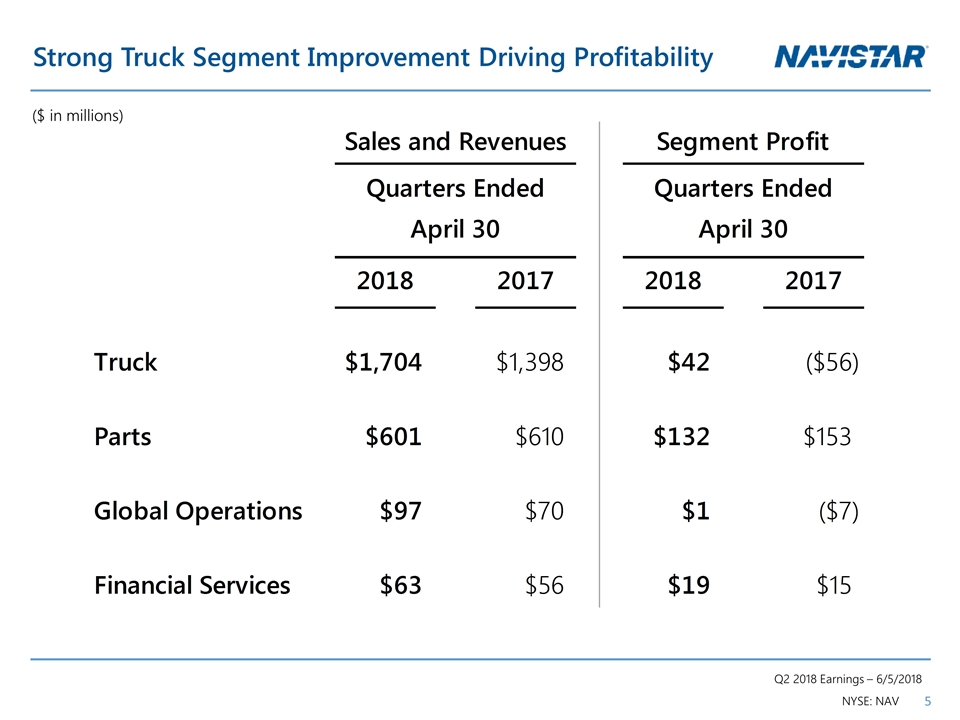
Strong Truck Segment Improvement Driving Profitability ($ in millions)
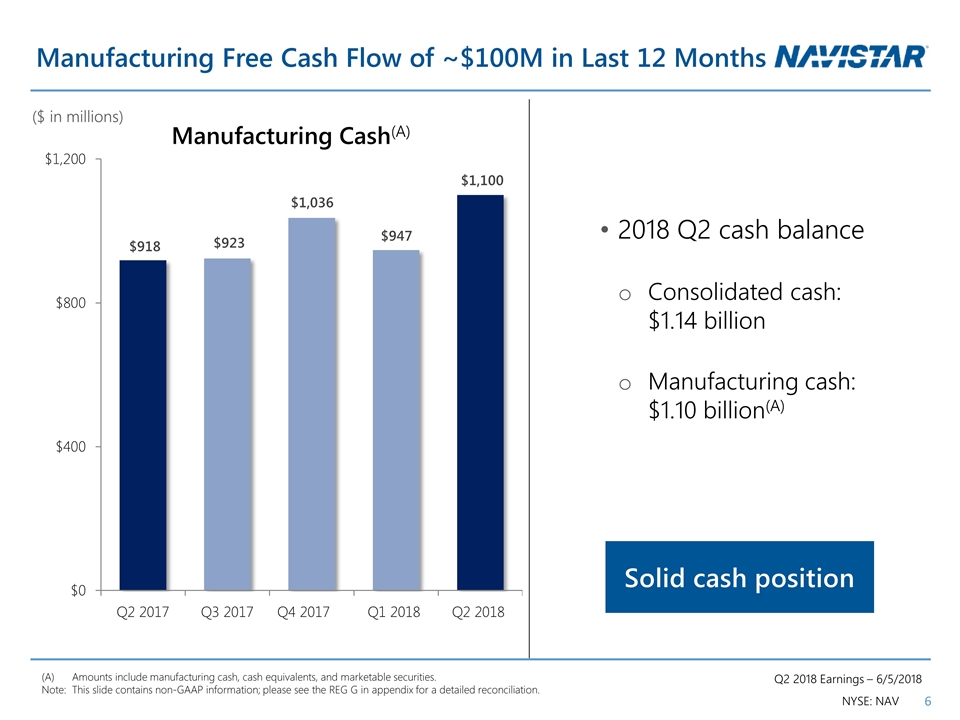
Manufacturing Free Cash Flow of ~$100M in Last 12 Months 2018 Q2 cash balance Consolidated cash: $1.14 billion Manufacturing cash: $1.10 billion(A) Manufacturing Cash(A) ($ in millions) Amounts include manufacturing cash, cash equivalents, and marketable securities. Note:This slide contains non-GAAP information; please see the REG G in appendix for a detailed reconciliation. Solid cash position
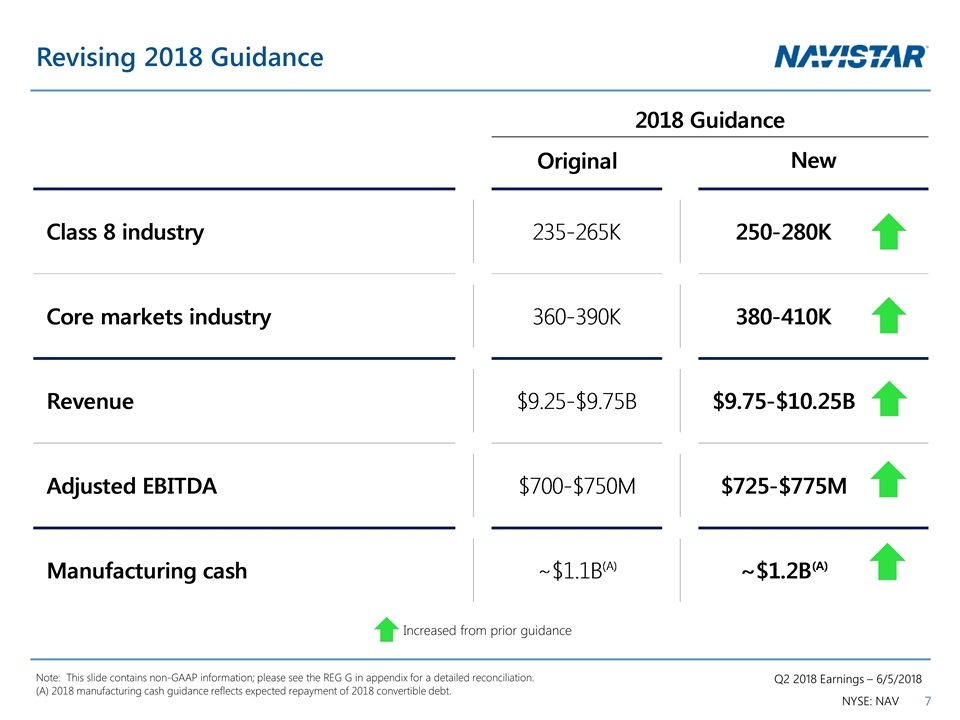
Revising 2018 Guidance Note:This slide contains non-GAAP information; please see the REG G in appendix for a detailed reconciliation. (A) 2018 manufacturing cash guidance reflects expected repayment of 2018 convertible debt. Increased from prior guidance
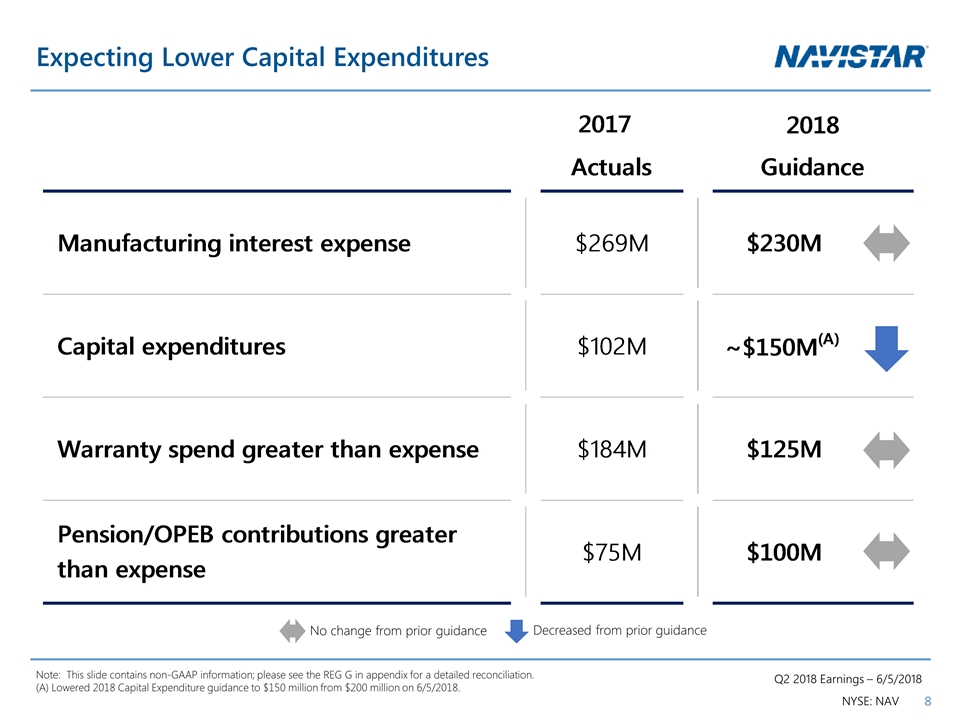
Expecting Lower Capital Expenditures Note:This slide contains non-GAAP information; please see the REG G in appendix for a detailed reconciliation. (A) Lowered 2018 Capital Expenditure guidance to $150 million from $200 million on 6/5/2018. No change from prior guidance Decreased from prior guidance
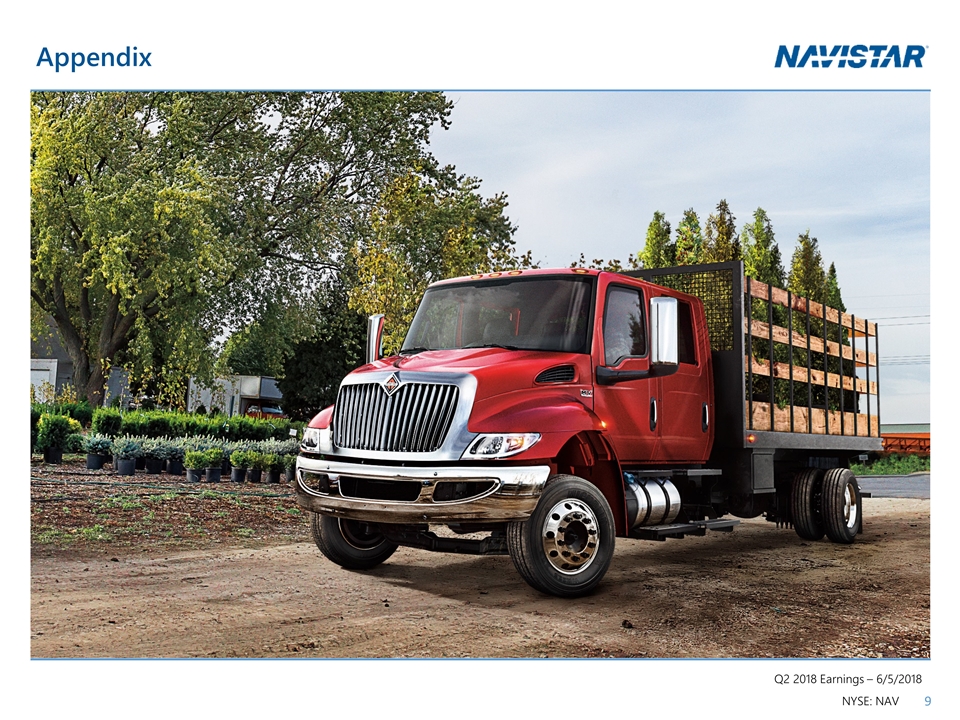
Appendix
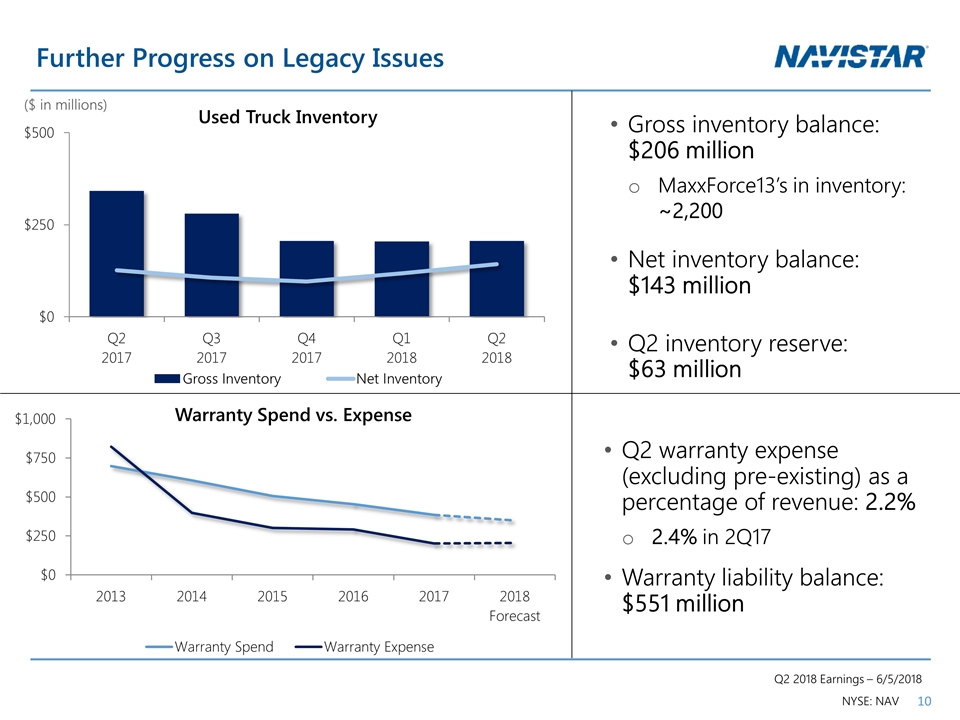
Further Progress on Legacy Issues Used Truck Inventory ($ in millions) Gross inventory balance: $206 million MaxxForce13’s in inventory: ~2,200 Net inventory balance: $143 million Q2 inventory reserve: $63 million Q2 warranty expense (excluding pre-existing) as a percentage of revenue: 2.2% 2.4% in 2Q17 Warranty liability balance: $551 million Warranty Spend vs. Expense
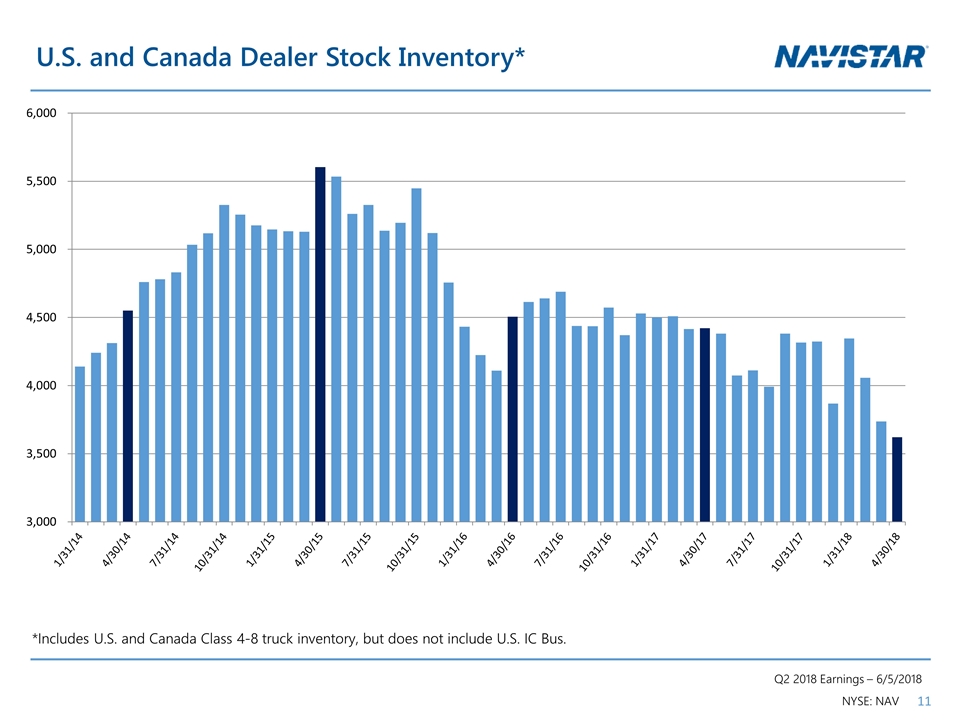
U.S. and Canada Dealer Stock Inventory* *Includes U.S. and Canada Class 4-8 truck inventory, but does not include U.S. IC Bus.
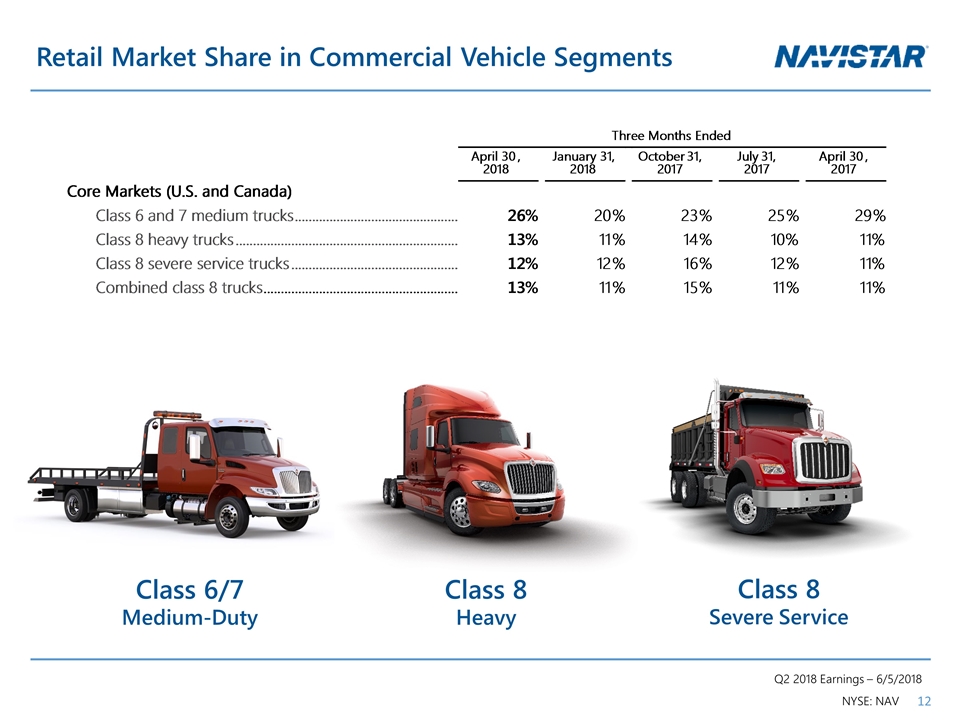
Retail Market Share in Commercial Vehicle Segments Class 6/7 Medium-Duty Class 8 Severe Service Class 8 Heavy
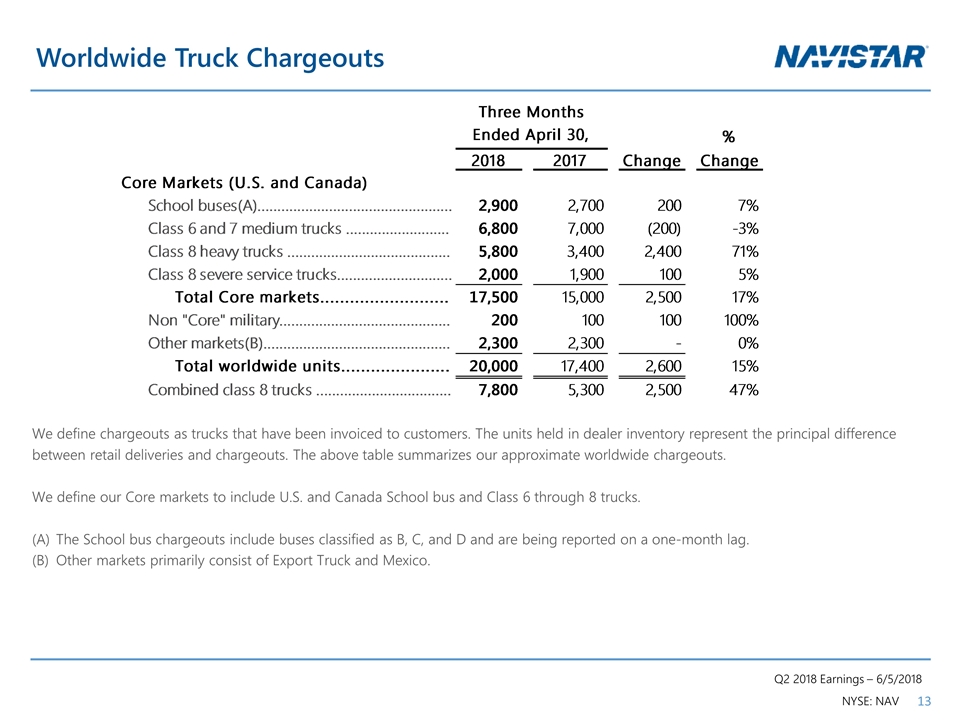
Worldwide Truck Chargeouts We define chargeouts as trucks that have been invoiced to customers. The units held in dealer inventory represent the principal difference between retail deliveries and chargeouts. The above table summarizes our approximate worldwide chargeouts. We define our Core markets to include U.S. and Canada School bus and Class 6 through 8 trucks. The School bus chargeouts include buses classified as B, C, and D and are being reported on a one-month lag. Other markets primarily consist of Export Truck and Mexico.
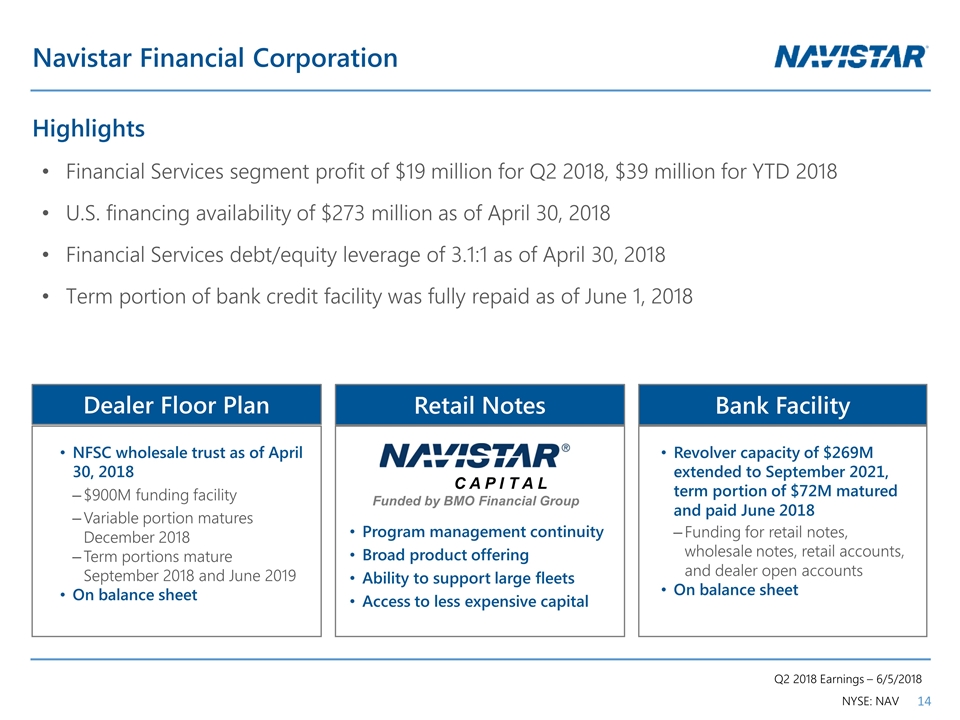
Highlights Financial Services segment profit of $19 million for Q2 2018, $39 million for YTD 2018 U.S. financing availability of $273 million as of April 30, 2018 Financial Services debt/equity leverage of 3.1:1 as of April 30, 2018 Term portion of bank credit facility was fully repaid as of June 1, 2018 Navistar Financial Corporation Retail Notes Bank Facility Dealer Floor Plan Revolver capacity of $269M extended to September 2021, term portion of $72M matured and paid June 2018 Funding for retail notes, wholesale notes, retail accounts, and dealer open accounts On balance sheet NFSC wholesale trust as of April 30, 2018 $900M funding facility Variable portion matures December 2018 Term portions mature September 2018 and June 2019 On balance sheet Program management continuity Broad product offering Ability to support large fleets Access to less expensive capital C A P I T A L Funded by BMO Financial Group
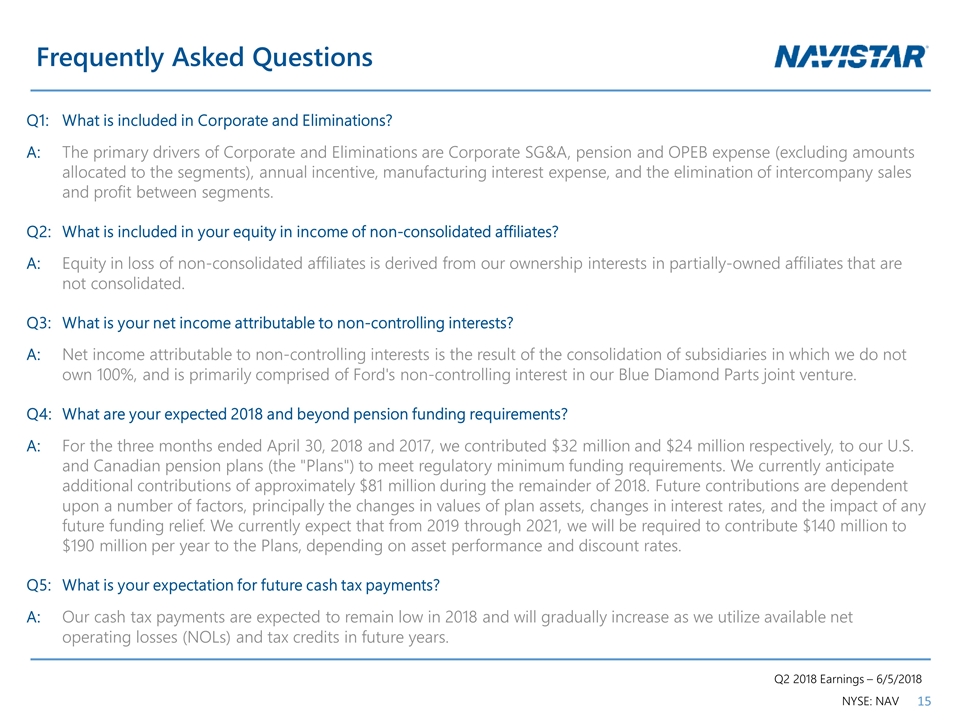
Frequently Asked Questions Q1: What is included in Corporate and Eliminations? A:The primary drivers of Corporate and Eliminations are Corporate SG&A, pension and OPEB expense (excluding amounts allocated to the segments), annual incentive, manufacturing interest expense, and the elimination of intercompany sales and profit between segments. Q2: What is included in your equity in income of non-consolidated affiliates? A:Equity in loss of non-consolidated affiliates is derived from our ownership interests in partially-owned affiliates that are not consolidated. Q3: What is your net income attributable to non-controlling interests? A:Net income attributable to non-controlling interests is the result of the consolidation of subsidiaries in which we do not own 100%, and is primarily comprised of Ford's non-controlling interest in our Blue Diamond Parts joint venture. Q4:What are your expected 2018 and beyond pension funding requirements? A: For the three months ended April 30, 2018 and 2017, we contributed $32 million and $24 million respectively, to our U.S. and Canadian pension plans (the "Plans") to meet regulatory minimum funding requirements. We currently anticipate additional contributions of approximately $81 million during the remainder of 2018. Future contributions are dependent upon a number of factors, principally the changes in values of plan assets, changes in interest rates, and the impact of any future funding relief. We currently expect that from 2019 through 2021, we will be required to contribute $140 million to $190 million per year to the Plans, depending on asset performance and discount rates. Q5:What is your expectation for future cash tax payments? A:Our cash tax payments are expected to remain low in 2018 and will gradually increase as we utilize available net operating losses (NOLs) and tax credits in future years.
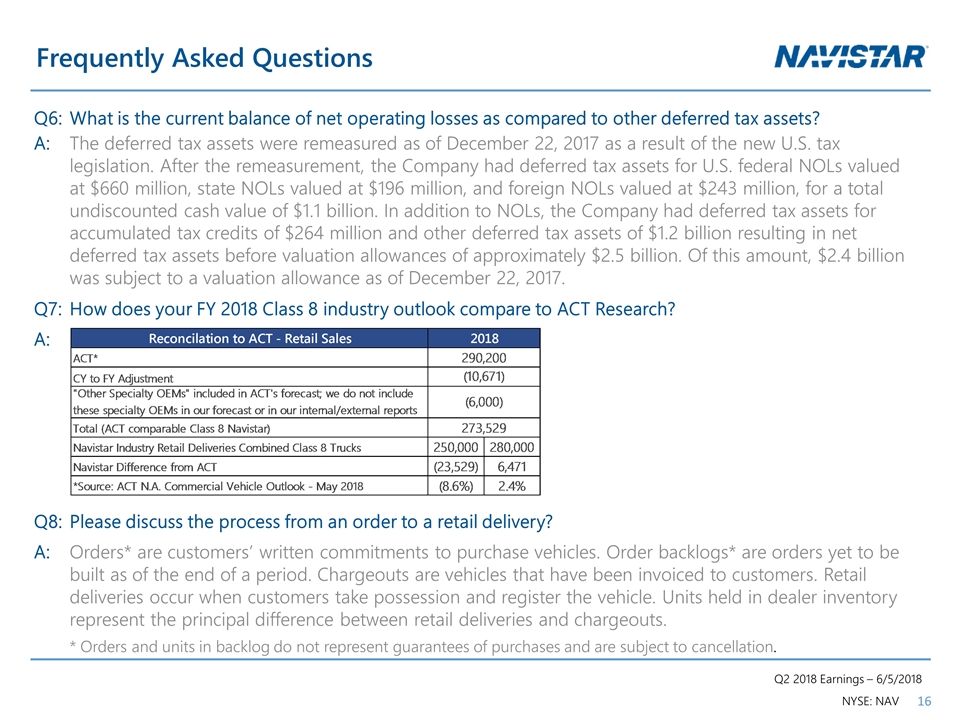
Frequently Asked Questions Q6:What is the current balance of net operating losses as compared to other deferred tax assets? A: The deferred tax assets were remeasured as of December 22, 2017 as a result of the new U.S. tax legislation. After the remeasurement, the Company had deferred tax assets for U.S. federal NOLs valued at $660 million, state NOLs valued at $196 million, and foreign NOLs valued at $243 million, for a total undiscounted cash value of $1.1 billion. In addition to NOLs, the Company had deferred tax assets for accumulated tax credits of $264 million and other deferred tax assets of $1.2 billion resulting in net deferred tax assets before valuation allowances of approximately $2.5 billion. Of this amount, $2.4 billion was subject to a valuation allowance as of December 22, 2017. Q7:How does your FY 2018 Class 8 industry outlook compare to ACT Research? A: Q8:Please discuss the process from an order to a retail delivery? A: Orders* are customers’ written commitments to purchase vehicles. Order backlogs* are orders yet to be built as of the end of a period. Chargeouts are vehicles that have been invoiced to customers. Retail deliveries occur when customers take possession and register the vehicle. Units held in dealer inventory represent the principal difference between retail deliveries and chargeouts. * Orders and units in backlog do not represent guarantees of purchases and are subject to cancellation.
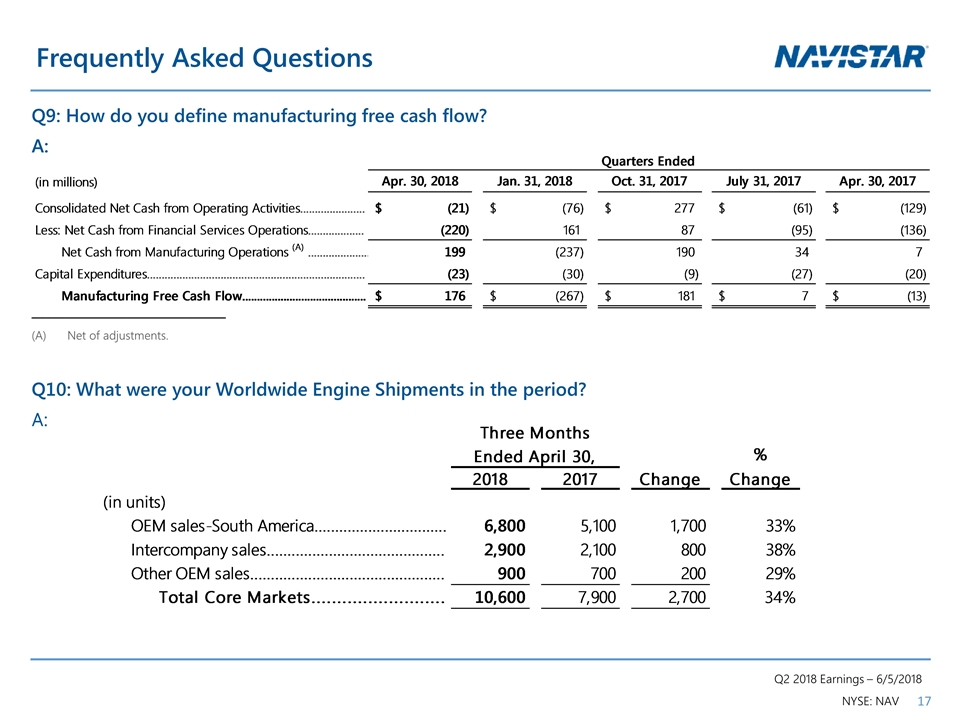
Frequently Asked Questions Q9: How do you define manufacturing free cash flow? A: _____________________________ Net of adjustments. Q10: What were your Worldwide Engine Shipments in the period? A:
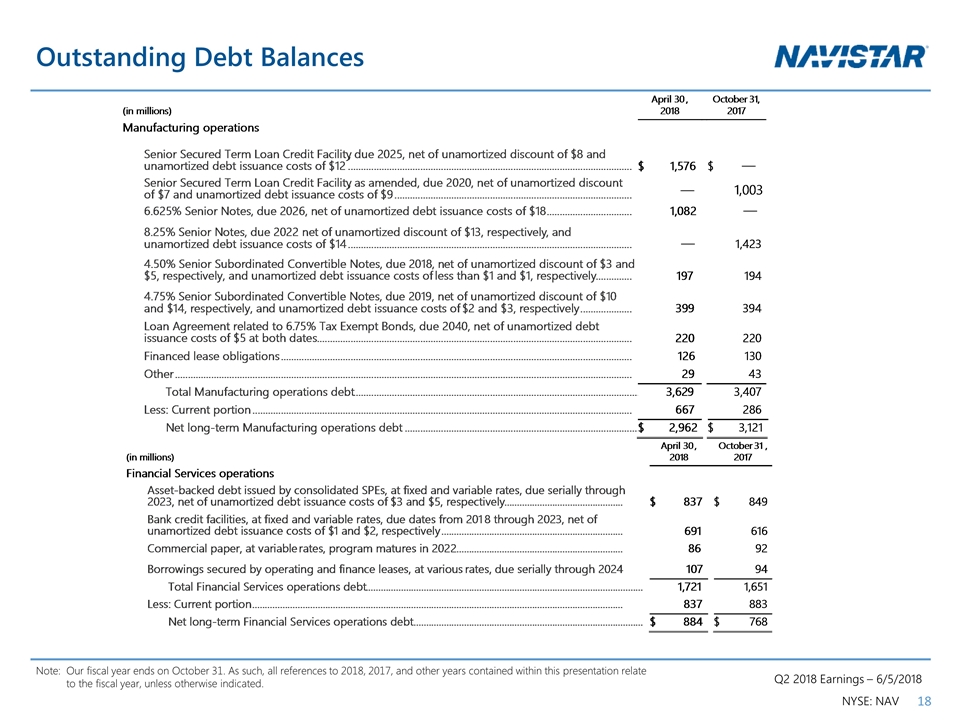
Outstanding Debt Balances Note:Our fiscal year ends on October 31. As such, all references to 2018, 2017, and other years contained within this presentation relate to the fiscal year, unless otherwise indicated.
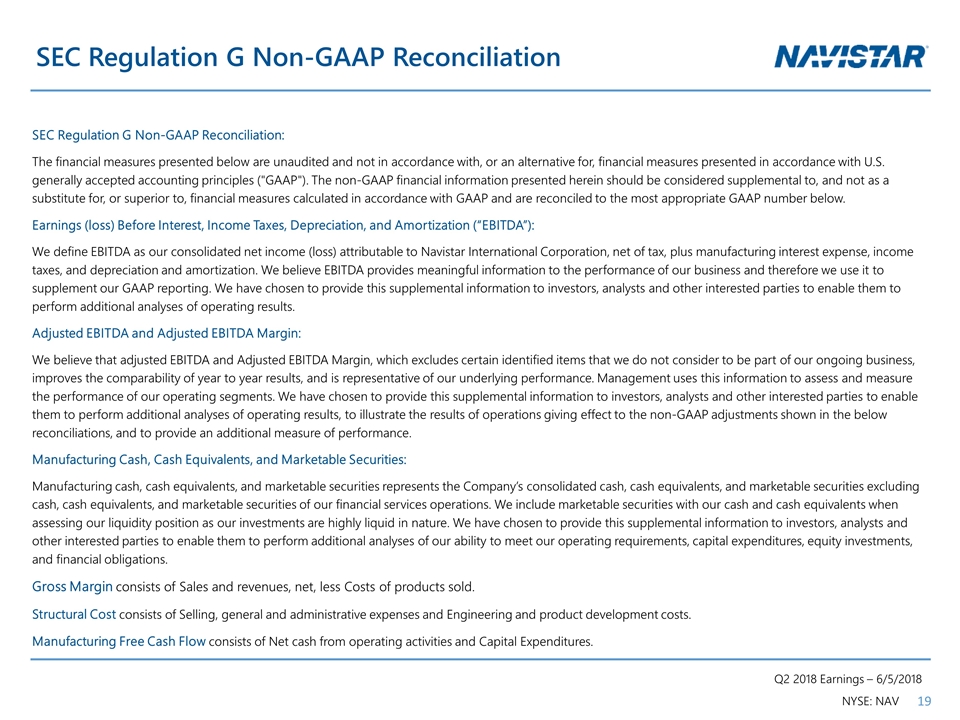
SEC Regulation G Non-GAAP Reconciliation SEC Regulation G Non-GAAP Reconciliation: The financial measures presented below are unaudited and not in accordance with, or an alternative for, financial measures presented in accordance with U.S. generally accepted accounting principles ("GAAP"). The non-GAAP financial information presented herein should be considered supplemental to, and not as a substitute for, or superior to, financial measures calculated in accordance with GAAP and are reconciled to the most appropriate GAAP number below. Earnings (loss) Before Interest, Income Taxes, Depreciation, and Amortization (“EBITDA”): We define EBITDA as our consolidated net income (loss) attributable to Navistar International Corporation, net of tax, plus manufacturing interest expense, income taxes, and depreciation and amortization. We believe EBITDA provides meaningful information to the performance of our business and therefore we use it to supplement our GAAP reporting. We have chosen to provide this supplemental information to investors, analysts and other interested parties to enable them to perform additional analyses of operating results. Adjusted EBITDA and Adjusted EBITDA Margin: We believe that adjusted EBITDA and Adjusted EBITDA Margin, which excludes certain identified items that we do not consider to be part of our ongoing business, improves the comparability of year to year results, and is representative of our underlying performance. Management uses this information to assess and measure the performance of our operating segments. We have chosen to provide this supplemental information to investors, analysts and other interested parties to enable them to perform additional analyses of operating results, to illustrate the results of operations giving effect to the non-GAAP adjustments shown in the below reconciliations, and to provide an additional measure of performance. Manufacturing Cash, Cash Equivalents, and Marketable Securities: Manufacturing cash, cash equivalents, and marketable securities represents the Company’s consolidated cash, cash equivalents, and marketable securities excluding cash, cash equivalents, and marketable securities of our financial services operations. We include marketable securities with our cash and cash equivalents when assessing our liquidity position as our investments are highly liquid in nature. We have chosen to provide this supplemental information to investors, analysts and other interested parties to enable them to perform additional analyses of our ability to meet our operating requirements, capital expenditures, equity investments, and financial obligations. Gross Margin consists of Sales and revenues, net, less Costs of products sold. Structural Cost consists of Selling, general and administrative expenses and Engineering and product development costs. Manufacturing Free Cash Flow consists of Net cash from operating activities and Capital Expenditures.
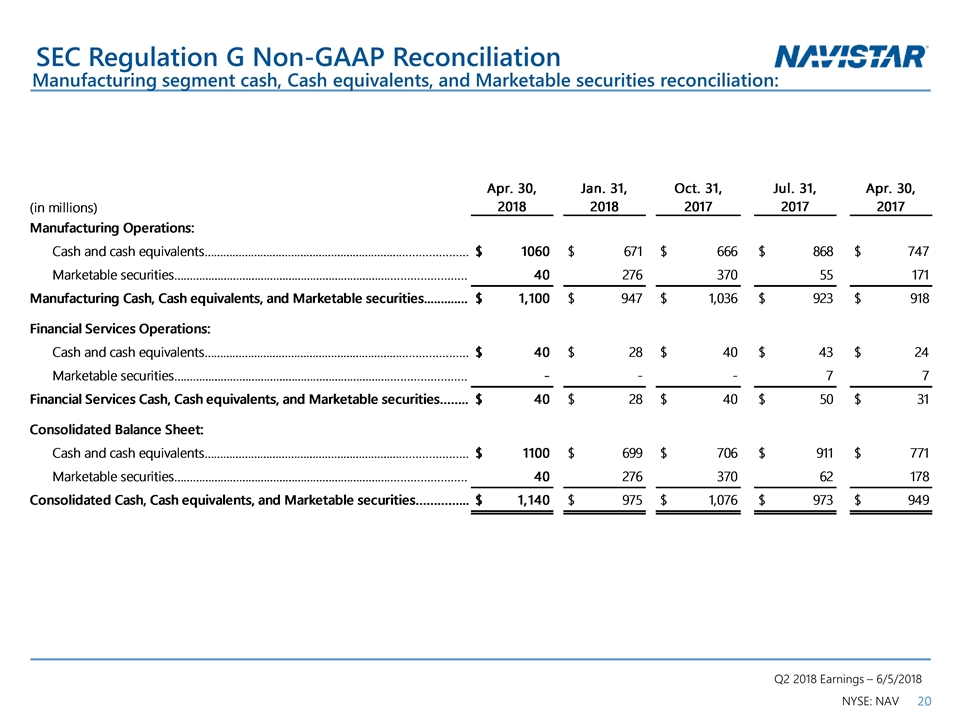
SEC Regulation G Non-GAAP Reconciliation Manufacturing segment cash, Cash equivalents, and Marketable securities reconciliation:
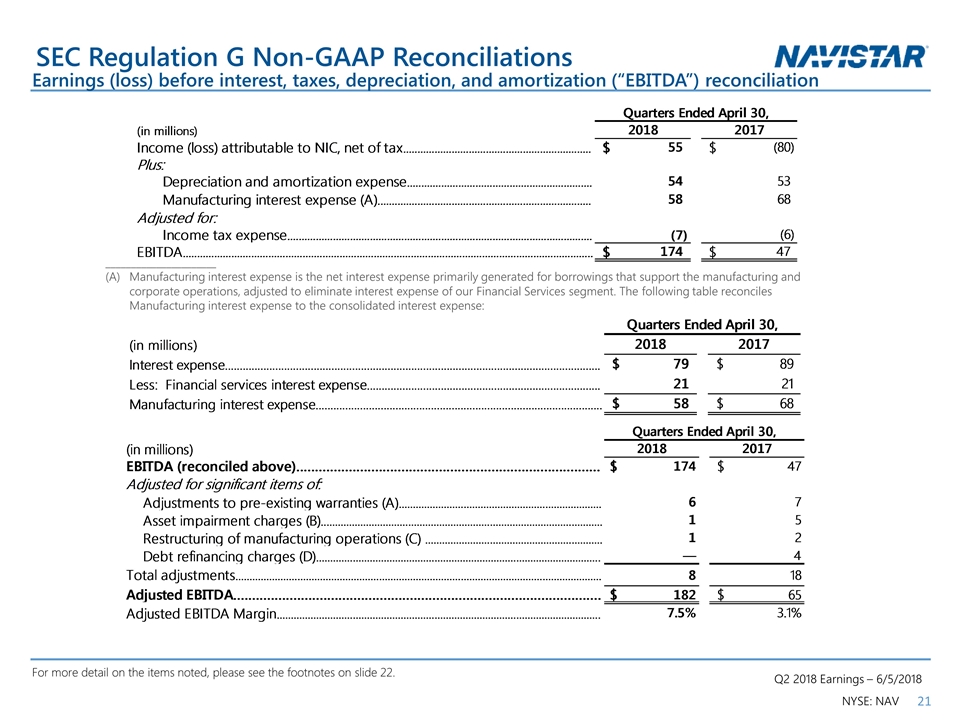
SEC Regulation G Non-GAAP Reconciliations Earnings (loss) before interest, taxes, depreciation, and amortization (“EBITDA”) reconciliation ______________________ (A) Manufacturing interest expense is the net interest expense primarily generated for borrowings that support the manufacturing and corporate operations, adjusted to eliminate interest expense of our Financial Services segment. The following table reconciles Manufacturing interest expense to the consolidated interest expense: For more detail on the items noted, please see the footnotes on slide 22.
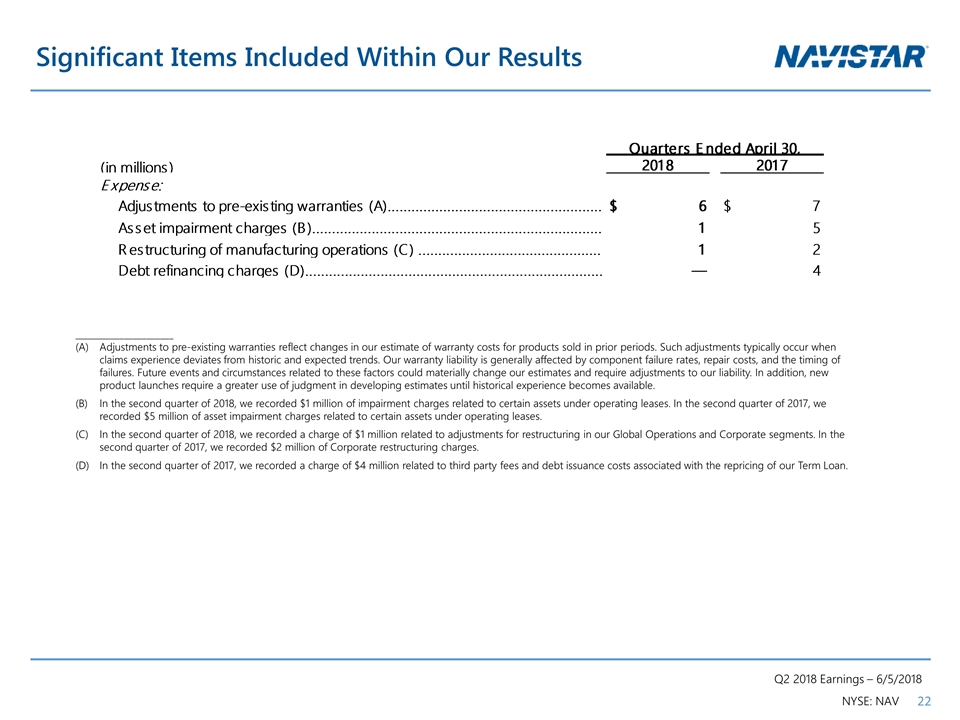
Significant Items Included Within Our Results ______________________ Adjustments to pre-existing warranties reflect changes in our estimate of warranty costs for products sold in prior periods. Such adjustments typically occur when claims experience deviates from historic and expected trends. Our warranty liability is generally affected by component failure rates, repair costs, and the timing of failures. Future events and circumstances related to these factors could materially change our estimates and require adjustments to our liability. In addition, new product launches require a greater use of judgment in developing estimates until historical experience becomes available. In the second quarter of 2018, we recorded $1 million of impairment charges related to certain assets under operating leases. In the second quarter of 2017, we recorded $5 million of asset impairment charges related to certain assets under operating leases. In the second quarter of 2018, we recorded a charge of $1 million related to adjustments for restructuring in our Global Operations and Corporate segments. In the second quarter of 2017, we recorded $2 million of Corporate restructuring charges. In the second quarter of 2017, we recorded a charge of $4 million related to third party fees and debt issuance costs associated with the repricing of our Term Loan. Quarters Ended April 30, (in millions) 2018 2017 Expense: Adjustments to pre-existing warranties (A) $ 6 $ 7 Asset impairment charges (B) 1 5 Restructuring of manufacturing operations (C) 1 2 Debt refinancing charges (D) — 4
